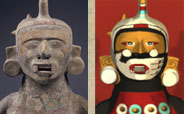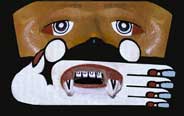The Face Comes to LifeConclusions drawn from fieldwork in the Valley of Oaxaca... allowed artists to construct a facsimile of the head of the Princeton effigy censer in ceramic, treat it with the proper plaster foundation, and reconstruct the original painting, clearly revealing the salient iconographic details, particularly the diagnostic white hand across the mouth.The body was painted black; indicative of a special ointment that Nahua priests rubbed into their skin. The neck was painted red, possibly suggesting a necklace of spondylous shell to which four alternating blue and white disks were attached. The wrists were ornamented with bracelets possibly colored blue to suggest turquoise mosaic. Both the bracelets and the necklace were finished with small golden bells emphasized in low relief. Facial paint features a band of yellow across the eyes and a white hand over the mouth. The thumb of the hand extends over the right cheek while the fingers, each tipped by a blue nail, extend around the left hand side of the jaw almost to the ear ornament. Fanged jaguar teeth protruding from the corners of the mouth are an allusion to the Maquiltonal’s principal nahual or spirit companion, a kind of animal alter ego. |







